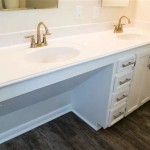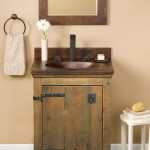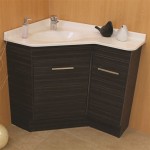Floating Bathroom Sink Cabinets: A Modern Solution for Space and Style
Floating bathroom sink cabinets, also known as wall-mounted vanities, have emerged as a popular choice in modern bathroom design. They offer a blend of aesthetic appeal, space-saving functionality, and ease of cleaning, making them a compelling alternative to traditional floor-standing vanities. This article delves into the various aspects of floating bathroom sink cabinets, exploring their advantages, design considerations, installation nuances, and maintenance requirements.
Advantages of Floating Bathroom Sink Cabinets
The primary appeal of floating vanities stems from the numerous advantages they offer compared to their floor-standing counterparts. Understanding these benefits is crucial for determining if a floating vanity is the right choice for a particular bathroom space.
Space Optimization: One of the most significant benefits is the illusion of increased space. By freeing up the floor area beneath the cabinet, floating vanities make even small bathrooms feel larger and more open. This is particularly beneficial in powder rooms or bathrooms with limited square footage. The visible floor space creates a sense of airiness and prevents the bathroom from feeling cramped.
Enhanced Accessibility and Cleaning: The open space beneath a floating vanity simplifies cleaning. There are no hard-to-reach corners or crevices where dust and grime can accumulate. Mops and cleaning supplies can easily access the entire floor, preventing the buildup of mold and mildew. Furthermore, this accessibility can be advantageous for individuals with mobility issues, allowing for easier maneuvering within the bathroom.
Modern Aesthetic: Floating vanities contribute to a sleek and contemporary aesthetic. Their minimalist design and clean lines complement modern bathroom styles, creating a sophisticated and uncluttered look. The floating effect adds a touch of elegance and sophistication, elevating the overall design of the room.
Customization Options: Floating vanities are available in a wide range of styles, sizes, materials, and finishes. This allows for extensive customization, enabling homeowners to select a vanity that perfectly matches their personal taste and the existing décor of the bathroom. From minimalist designs with integrated sinks to more elaborate models with drawers and shelves, the options are virtually limitless.
Flexibility in Installation Height: Unlike floor-standing vanities with a fixed height, floating vanities offer flexibility in installation height. This allows for customization to accommodate the specific needs of the users. For example, a higher installation height may be preferred for taller individuals or those with back problems, while a lower height may be more suitable for children.
Design Considerations for Floating Bathroom Sink Cabinets
Selecting the right floating vanity involves careful consideration of several design factors. These considerations ensure that the chosen vanity not only complements the bathroom's aesthetic but also meets the functional requirements of the space.
Size and Dimensions: The size of the vanity should be proportional to the dimensions of the bathroom. In small bathrooms, a compact vanity with minimal storage may be ideal. Larger bathrooms can accommodate larger vanities with ample storage space. It is essential to measure the available space accurately before selecting a vanity to ensure a proper fit.
Material Selection: The material of the vanity should be durable, water-resistant, and easy to clean. Common materials include wood, MDF (Medium-Density Fiberboard), plywood, and solid surface materials. Solid wood offers a classic and durable option, while MDF and plywood are more affordable alternatives. Solid surface materials are highly resistant to moisture and stains, making them ideal for bathroom environments.
Storage Requirements: Consider the storage needs of the users when selecting a vanity. Drawers provide convenient storage for toiletries and personal care items, while shelves offer space for towels and larger items. The number and configuration of drawers and shelves should be tailored to the specific storage requirements of the household.
Sink Type: Floating vanities can accommodate various sink types, including vessel sinks, undermount sinks, and integrated sinks. Vessel sinks sit on top of the vanity, adding a decorative element. Undermount sinks are installed beneath the countertop, creating a seamless and easy-to-clean surface. Integrated sinks are molded directly into the countertop, offering a sleek and modern look.
Style and Finish: The style and finish of the vanity should complement the overall aesthetic of the bathroom. Modern bathrooms often feature minimalist designs with clean lines and neutral colors. Traditional bathrooms may incorporate more ornate details and warmer tones. The finish of the vanity should be durable and resistant to moisture damage.
Installation and Structural Support of Floating Vanities
Proper installation is crucial for ensuring the stability and longevity of a floating vanity. Unlike floor-standing vanities that rest on the floor, floating vanities rely on wall mounting for support. Therefore, adequate structural support is essential to prevent the vanity from sagging or detaching from the wall.
Locating Wall Studs: The first step in installation is to locate the wall studs behind the drywall. Wall studs provide the necessary support for the vanity. A stud finder can be used to locate the studs accurately. The vanity should be securely attached to at least two wall studs for maximum stability.
Using Mounting Brackets: Heavy-duty mounting brackets are typically used to support the weight of the vanity. These brackets are attached to the wall studs and provide a secure platform for the vanity to rest on. The brackets should be rated to support the expected weight of the vanity and itscontents.
Ensuring Proper Leveling: It is essential to ensure that the vanity is perfectly level before securing it to the wall. A level can be used to check the horizontal and vertical alignment of the vanity. Shims can be used to make adjustments as needed.
Reinforcing the Wall (If Necessary): In some cases, the wall may require additional reinforcement to support the weight of the vanity. This may involve adding extra wall studs or installing a plywood backing behind the drywall. A professional contractor can assess the wall's structural integrity and recommend the necessary reinforcements.
Professional Installation: While it is possible to install a floating vanity as a DIY project, it is often recommended to hire a professional plumber and/or contractor, especially if plumbing modifications are required. A professional can ensure that the vanity is installed correctly and safely, minimizing the risk of future problems.
Weight Considerations: It's critical to consider the weight capacity of the chosen floating vanity, especially when selecting countertop materials like stone or concrete. These heavier materials can place significant strain on the wall mounting system. Ensure both the vanity and the mounting hardware are rated to handle the combined weight to prevent potential failures.
Plumbing Access: Before installing the vanity, carefully plan the placement of water supply lines and drainpipes. Ensure they are positioned to align properly with the sink and faucet connections. It might be necessary to relocate plumbing lines to accommodate the floating vanity's configuration. Allowing sufficient space for access to shut-off valves and drain connections is also important for future maintenance. A small access panel could be incorporated into the design for ease of maintenance.
Electrical Considerations: If electrical outlets or wiring are required near the vanity (for things like lighting or electric mirrors), ensure they are planned and installed before the vanity is mounted. Following local electrical codes is crucial for safety.
Maintenance and Care of Floating Bathroom Sink Cabinets
Proper maintenance is essential for preserving the appearance and functionality of a floating vanity. Regular cleaning and preventative measures can help extend the lifespan of the vanity and prevent damage.
Regular Cleaning: The vanity should be cleaned regularly with a mild soap and water solution. Avoid using abrasive cleaners or scouring pads, as these can damage the finish. Wipe up spills immediately to prevent staining.
Protecting from Moisture: Moisture is the primary enemy of bathroom cabinets. Ensure that the bathroom is well-ventilated to prevent the buildup of humidity. Wipe down the vanity after each use to remove excess moisture. Repair any leaks promptly to prevent water damage.
Inspecting for Damage: Regularly inspect the vanity for signs of damage, such as cracks, chips, or water stains. Repair any damage promptly to prevent further deterioration.
Tightening Hardware: Periodically check the mounting hardware to ensure that it is securely fastened. Tighten any loose screws or bolts to prevent the vanity from becoming unstable.
Preventative Measures: Consider applying a sealant or protectant to the vanity to protect it from moisture and stains. This can help extend the lifespan of the vanity and keep it looking its best.
Conclusion
Floating bathroom sink cabinets offer a compelling combination of style, functionality, and space-saving benefits. Their modern aesthetic, coupled with ease of cleaning and customization options, makes them a desirable choice for contemporary bathrooms. Careful consideration of design factors, proper installation techniques, and regular maintenance are essential for ensuring the longevity and performance of these stylish and practical bathroom fixtures.

27 Floating Sink Cabinets And Bathroom Vanity Ideas Vanities Designs Elegant Design

27 Floating Sink Cabinets And Bathroom Vanity Ideas Decoist

Modern 39 Floating Black Bathroom Vanity Stone Top Wall Mounted Cabinet Homary

Floating Bathroom Vanities Guide Victoriaplum Com

Modern 36 Floating Bathroom Vanity Wall Mount Single Sink Homary Vanities Unique

Acf Lor57 Bathroom Vanity Loren Nameek S

Linea Wall Hung Handleless Vanity Unit Harvey George

How To Install A Veneto Bath Floating Bathroom Vanity

Free On 800mm Black White Floating Bathroom Vanity Faux Marble Top Ceramic Countertop Basin Homary

Celeste Double Basin Floating Bathroom Vanity Denver Furniture Buildsaver
Related Posts







